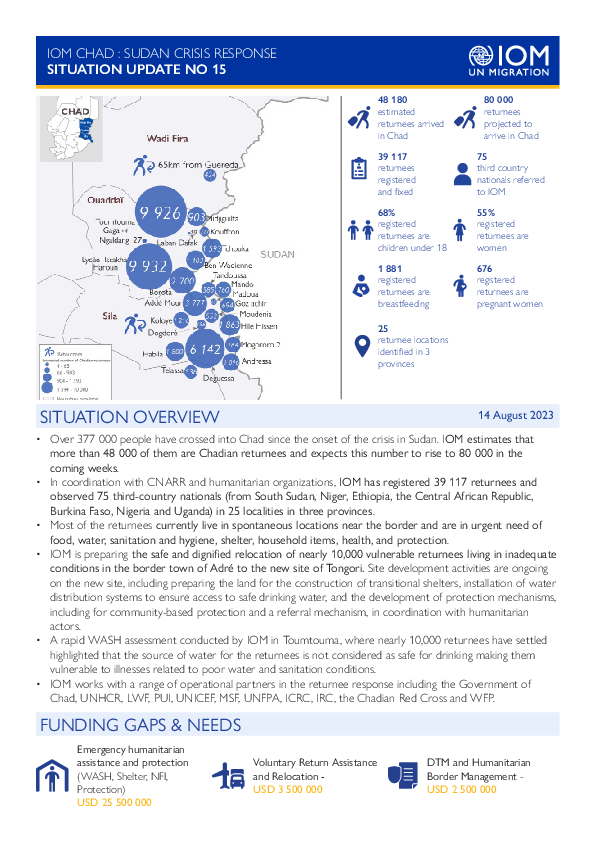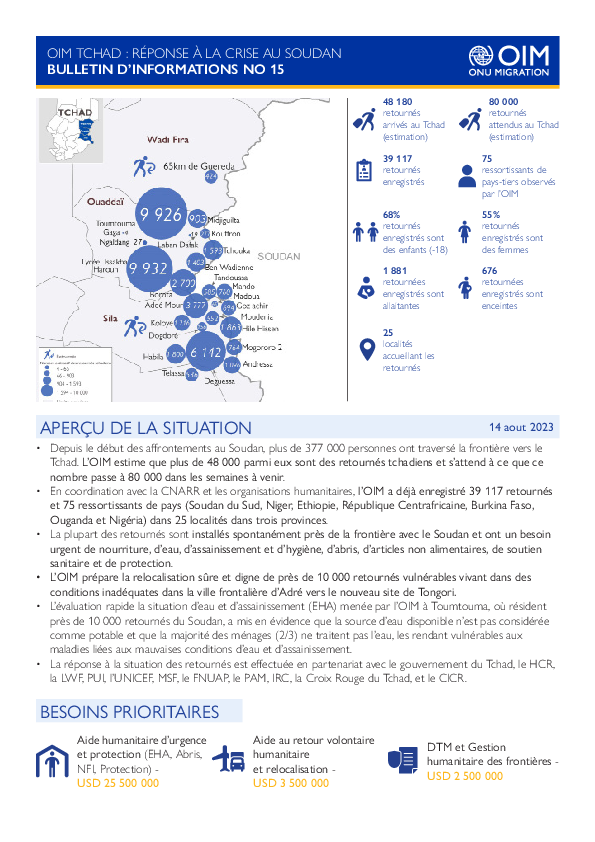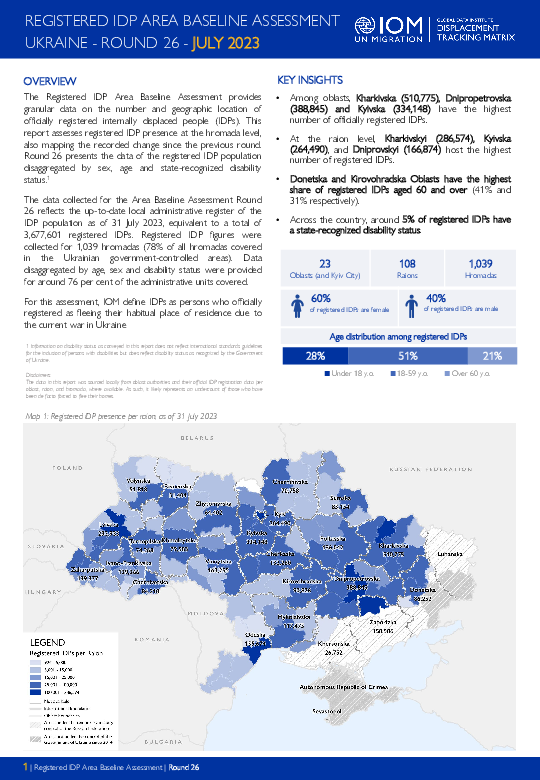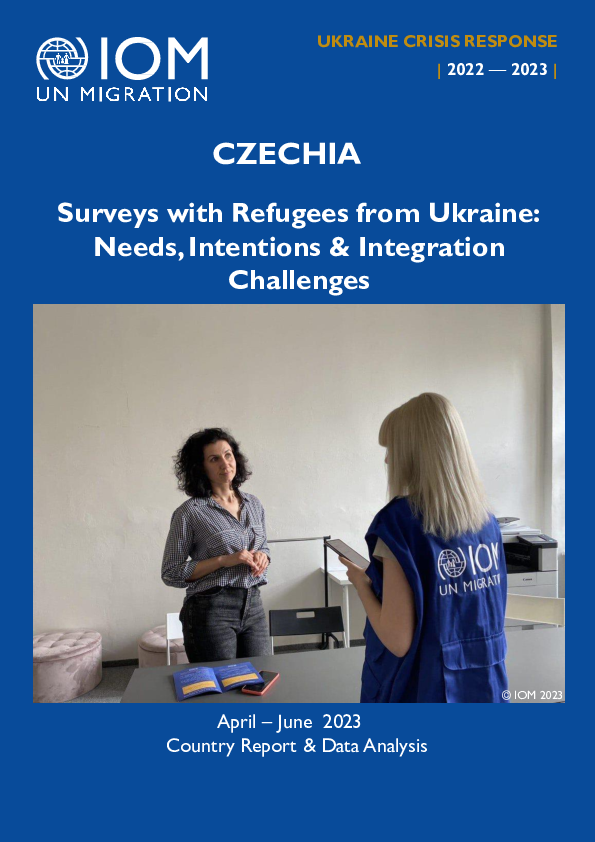-
Countries
-
Data and Analysis
-
Special Focus
-
Crisis Responses

Contact
DTM Chad, dtmtchad@iom.int
Language
English
Location
Chad
Period Covered
Aug 14 2023
Aug 14 2023
Activity
- Flow Monitoring Survey
- Flow Monitoring
Over 377 000 people have crossed into Chad since the onset of the crisis in Sudan. IOM estimates that more than 48 000 of them are Chadian returnees and expects this number to rise to 80 000 in the coming weeks. In coordination with CNARR and humanitarian organizations, IOM has registered 39 117 returnees and observed 75 third-country nationals (from South Sudan, Niger, Ethiopia, the Central African Republic, Burkina Faso, Nigeria and Uganda) in 25 localities in three provinces. Most of the returnees currently live in spontaneous locations near the border and are in urgent need of food, water, sanitation and hygiene, shelter, household items, health, and protection. IOM is preparing the safe and dignified relocation of nearly 10,000 vulnerable returnees living in inadequate conditions in the border town of Adré to the new site of Tongori. Site development activities are ongoing on the new site, including preparing the land for the construction of transitional shelters, installation of water distribution systems to ensure access to safe drinking water, and the development of protection mechanisms, including for community-based protection and a referral mechanism, in coordination with humanitarian actors. A rapid WASH assessment conducted by IOM in Toumtouma, where nearly 10,000 returnees have settled highlighted that the source of water for the returnees is not considered as safe for drinking making them vulnerable to illnesses related to poor water and sanitation conditions. IOM works with a range of operational partners in the returnee response including the Government of Chad, UNHCR, LWF, PUI, UNICEF, MSF, UNFPA, ICRC, IRC, the Chadian Red Cross and WFP.

Contact
DTM Chad, dtmtchad@iom.int
Language
French
Location
Chad
Period Covered
Aug 14 2023
Aug 14 2023
Activity
- Flow Monitoring Survey
- Flow Monitoring
Depuis le début des affrontements au Soudan, plus de 377 000 personnes ont traversé la frontière vers le Tchad. L’OIM estime que plus de 48 000 parmi eux sont des retournés tchadiens et s’attend à ce que ce nombre passe à 80 000 dans les semaines à venir. • En coordination avec la CNARR et les organisations humanitaires, l’OIM a déjà enregistré 39 117 retournés et 75 ressortissants de pays (Soudan du Sud, Niger, Ethiopie, République Centrafricaine, Burkina Faso, Ouganda et Nigéria) dans 25 localités dans trois provinces. La plupart des retournés sont installés spontanément près de la frontière avec le Soudan et ont un besoin urgent de nourriture, d’eau, d’assainissement et d’hygiène, d’abris, d’articles non alimentaires, de soutien sanitaire et de protection. L’OIM prépare la relocalisation sûre et digne de près de 10 000 retournés vulnérables vivant dans des conditions inadéquates dans la ville frontalière d’Adré vers le nouveau site de Tongori. L’évaluation rapide la situation d’eau et d’assainissement (EHA) menée par l’OIM à Toumtouma, où résident près de 10 000 retournés du Soudan, a mis en évidence que la source d’eau disponible n’est pas considérée comme potable et que la majorité des ménages (2/3) ne traitent pas l’eau, les rendant vulnérables aux maladies liées aux mauvaises conditions d’eau et d’assainissement. La réponse à la situation des retournés est effectuée en partenariat avec le gouvernement du Tchad, le HCR, la LWF, PUI, l’UNICEF, MSF, le FNUAP, le PAM, IRC, la Croix Rouge du Tchad, et le CICR.

Contact
DTMUkraine@iom.int
Language
English
Location
Ukraine
Snapshot Date
Jul 31 2023
Activity
- Baseline Assessment
The Registered IDP Area Baseline Assessment provides granular data on the number and geographic location of officially registered internally displaced people (IDPs). This report assesses registered IDP presence at the hromada level, also mapping the recorded change since the previous round. Round 26 presents the data of the registered IDP population disaggregated by sex, age and state-recognized disability status.
The data collected for the Area Baseline Assessment Round 26 reflects the up-to-date local administrative register of the IDP population as of 31 July 2023, equivalent to a total of 3,677,601 registered IDPs. Registered IDP figures were collected for 1,039 hromadas (78% of all hromadas covered in the Ukrainian government-controlled areas). Data disaggregated by age, sex and disability status were provided for around 76 per cent of the administrative units covered. For this assessment, IOM define IDPs as persons who officially registered as fleeing their habitual place of residence due to the current war in Ukraine

Contact
DTM Europe, DTMMediterranean@iom.int
Language
English
Location
Czechia
Period Covered
Apr 01 2023
Jun 30 2023
Activity
- Survey
- Flow Monitoring
This report is based on a survey of displacement patterns, needs and intentions conducted by IOM’s Displacement Tracking Matrix (DTM) in the countries included in the Regional Response Plan for Ukraine in 2023: 6 countries neighbouring Ukraine – Belarus, Hungary, Poland, Republic of Moldova, Romania and Slovakia – and other 5 countries particularly impacted by the arrivals of refugees from Ukraine since the start of the war in February 2022 – Bulgaria, Czechia, Estonia, Latvia and Lithuania.
• Top oblasts of origin: Kharkivska (11%), city of Kyiv and Zaporizka (10% each) and Donetska (9%).
• Intentions to move: no intention to move (76%), back to the place of origin in Ukraine (10%), to another country (3%)
• Top 3 needs upon return:* cash support (28%), job placement (20%) and housing (20%).
• Economic status: employed (41%), unemployed and looking for a job (21%), daily worker (10%), self-employed (4%), student, unemployed and not looking for a job (5%), maternity/paternity leave (6%), retired (9%).
• Top three inclusion challenges:* finding suitable job (48%), language barrier (53%) and long-term housing (39%).
* more than one answer possible

Contact
dtmhaiti@iom.int
Language
English
Location
Haiti
Period Covered
Aug 14 2023
Aug 14 2023
Activity
- Mobility Tracking
- Event Tracking
Between 12 and 13 August 2023, armed violence took place in the neighborhoods of Carrefour-Feuille and Savanes Pistaches, located in the commune of Port-au-Prince (West Department). This violence caused the displacement of approximately 717 households (3,556 individuals), most of whom (89%) took refuge in 7 sites

Contact
DTM Yemen, iomyemendtm@iom.int
Language
English
Location
Yemen
Period Covered
Aug 06 2023
Aug 12 2023
Activity
- Rapid Emergency Registration
- Mobility Tracking
IOM Yemen DTM’s Rapid Displacement Tracking (RDT) tool collects data on estimated numbers of households forced to flee on a daily basis from their locations of origin or displacement, allowing for regular reporting of new displacements in terms of estimated numbers, geography, and needs. It also tracks returnees who returned to their location of origin.
From 1 January to 12 August 2023, IOM Yemen DTM tracked 4,050 households (HH) (24,300 Individuals) who experienced displacement at least once.
Between 6 and 12 August 2023, IOM Yemen DTM tracked 60 households (360 individuals) displaced at least once. The majority of people moved into/within the following governorates and districts:
- Al Hodeidah (37 HHs) – Hays (29 HHs), Al Khukhah (8 HHs) districts. Most displacements in the governorate originated from Ta’iz and Al Hodeidah.
- Hadramawt (8 HHs) – Ar Raydah wa Qussayar (8 HHs) district. All displacements in the governorate originated from Al Hodeidah.
- Ta’iz (8 HHs) – Al Maafer (5 HHs), As Silw (2 HHs), Al Mudhaffar (1 HH) districts. Most displacements in the governorate originated from Ta’iz and Aden.
The majority of people moved from the following governorates and districts:
- Ta’iz (28 HHs) – Maqbanah (25 HHs), At Ta’iziyah (3 HHs) districts.
- Al Hodeidah (26 HHs) – Hays (12 HHs), Al Khukhah (6 HHs), At Tuhayta (4 HHs) districts.
- Ad Dali (2 HHs) – Jahaf (1 HH), Qatabah (1 HH) districts.
Contact
DTM Yemen, iomyemendtm@iom.int
Location
Yemen
Activity
- Mobility Tracking
- Event Tracking
Period Covered
Aug 06 2023 -Aug 12 2023
From 1 January to 12 August 2023, IOM Yemen DTM tracked 4,050 households (HH) (24,300 Individuals) who experienced displacement at least once.
Between 6 and 12 August 2023, IOM Yemen DTM tracked 60 households (360 individuals) displaced at least once. The majority of people moved into/within the following governorates and districts:
- Al Hodeidah (37 HHs) – Hays (29 HHs), Al Khukhah (8 HHs) districts. Most displacements in the governorate originated from Ta’iz and Al Hodeidah.
- Hadramawt (8 HHs) – Ar Raydah wa Qussayar (8 HHs) district. All displacements in the governorate originated from Al Hodeidah.
- Ta’iz (8 HHs) – Al Maafer (5 HHs), As Silw (2 HHs), Al Mudhaffar (1 HH) districts. Most displacements in the governorate originated from Ta’iz and Aden.
- Ta’iz (28 HHs) – Maqbanah (25 HHs), At Ta’iziyah (3 HHs) districts.
- Al Hodeidah (26 HHs) – Hays (12 HHs), Al Khukhah (6 HHs), At Tuhayta (4 HHs) districts.
- Ad Dali (2 HHs) – Jahaf (1 HH), Qatabah (1 HH) districts.
Population Groups
Survey Methodology
Unit of Analysis Or Observation
Type of Survey or Assessment
Keywords
Geographical Scope
Administrative boundaries with available data
The current dataset covers the following administrative boundaries
Contact
DTM Sudan, DTMSudan@iom.int
Location
Sudan
Activity
- Mobility Tracking
- Baseline Assessment
Period Covered
May 19 2023 -Aug 02 2023
The current total estimate of recently displaced individuals across Sudan has reached 3,282,303 Individuals (656,292 Households).
The current assessment has observed the IDP caseload in all of Sudan’s 18 states. The highest proportions of IDPs have been observed in River Nile (14.91%), Northern (10.99%), North Darfur (8.44%), and White Nile (8.43%) states.
Field teams report that the IDPs observed were originally displaced from eight states. The majority (71.24%) have been reportedly displaced from Khartoum state; followed by North Darfur (8.54%), South Darfur (7.52%), West Darfur (7.24%), Central Darfur (4.48%), North Kordofan (0.50%), South Kordofan (0.47%), and Aj Jazirah (0.01%).
In addition to the internal displacement, the conflict in Sudan has caused the Mixed Cross-Border Movements of 968,451 individuals into neighbouring countries.
Population Groups
Survey Methodology
Unit of Analysis Or Observation
Type of Survey or Assessment
Keywords
Geographical Scope
Administrative boundaries with available data
The current dataset covers the following administrative boundaries
Contact
DTM Ethiopia, DTMEthiopia@iom.int
Location
Ethiopia
Activity
- Mobility Tracking
- Village Assessment
Period Covered
Apr 27 2023 -Jun 29 2023
In Tigray village assessment survey round 16, 963 villages were covered. 1,256,297 returning IDPs and 296,229 returning IDP households were identified.
Population Groups
Survey Methodology
Unit of Analysis Or Observation
Type of Survey or Assessment
Keywords
Geographical Scope
Administrative boundaries with available data
The current dataset covers the following administrative boundaries
Contact
DTM Ethiopia, DTMEthiopia@iom.int
Location
Ethiopia
Activity
- Mobility Tracking
- Site Assessment
Period Covered
Apr 19 2023 -Jun 28 2023
In Tigray site assessment round 33, 643 sites were covered. 1,021,798 IDPs and 250,468 IDP households were identified.
Population Groups
Survey Methodology
Unit of Analysis Or Observation
Type of Survey or Assessment
Keywords
Geographical Scope
Administrative boundaries with available data
The current dataset covers the following administrative boundaries